Huizhi Wang
A Tutorial on MIMO-OFDM ISAC: From Far-Field to Near-Field
Apr 27, 2025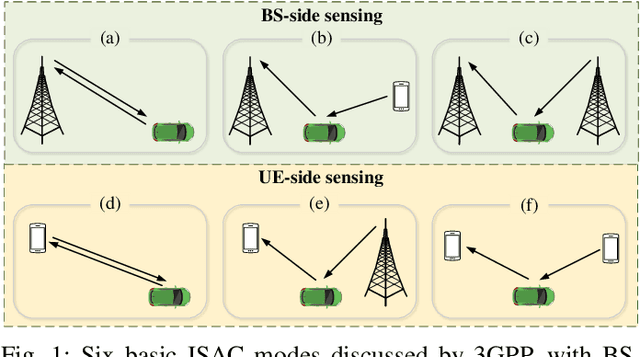
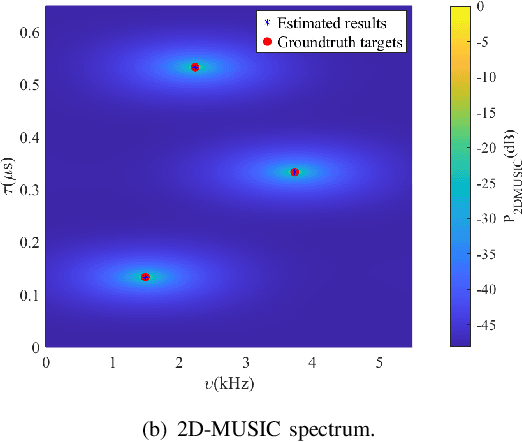

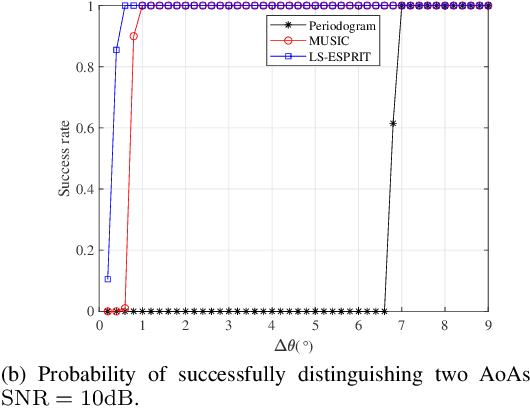
Abstract:Integrated sensing and communication (ISAC) is one of the key usage scenarios for future sixth-generation (6G) mobile communication networks, where communication and sensing (C&S) services are simultaneously provided through shared wireless spectrum, signal processing modules, hardware, and network infrastructure. Such an integration is strengthened by the technology trends in 6G, such as denser network nodes, larger antenna arrays, wider bandwidths, higher frequency bands, and more efficient utilization of spectrum and hardware resources, which incentivize and empower enhanced sensing capabilities. As the dominant waveform used in contemporary communication systems, orthogonal frequency division multiplexing (OFDM) is still expected to be a very competitive technology for 6G, rendering it necessary to thoroughly investigate the potential and challenges of OFDM ISAC. Thus, this paper aims to provide a comprehensive tutorial overview of ISAC systems enabled by large-scale multi-input multi-output (MIMO) and OFDM technologies and to discuss their fundamental principles, advantages, and enabling signal processing methods. To this end, a unified MIMO-OFDM ISAC system model is first introduced, followed by four frameworks for estimating parameters across the spatial, delay, and Doppler domains, including parallel one-domain, sequential one-domain, joint two-domain, and joint three-domain parameter estimation. Next, sensing algorithms and performance analyses are presented in detail for far-field scenarios where uniform plane wave (UPW) propagation is valid, followed by their extensions to near-field scenarios where uniform spherical wave (USW) characteristics need to be considered. Finally, this paper points out open challenges and outlines promising avenues for future research on MIMO-OFDM ISAC.
FFT-Enhanced Low-Complexity Near-Field Super-Resolution Sensing
Nov 23, 2024Abstract:In this letter, a fast Fourier transform (FFT)-enhanced low-complexity super-resolution sensing algorithm for near-field source localization with both angle and range estimation is proposed. Most traditional near-field source localization algorithms suffer from excessive computational complexity or incompatibility with existing array architectures. To address such issues, this letter proposes a novel near-field sensing algorithm that combines coarse and fine granularity of spectrum peak search. Specifically, a spectral pattern in the angle domain is first constructed using FFT to identify potential angles where sources are present. Afterwards, a 1D beamforming is performed in the distance domain to obtain potential distance regions. Finally, a refined 2D multiple signal classification (MUSIC) is conducted within each narrowed angle-distance region to estimate the precise location of the sources. Numerical results demonstrate that the proposed algorithm can significantly reduce the computational complexity of 2D spectrum peak searches and achieve target localization with high-resolution.
Convolutional Beamspace Beamforming for Low-Complexity Far-Field and Near-Field MU-MIMO Communications
Sep 02, 2024Abstract:Inter-user interference (IUI) mitigation has been an essential issue for multi-user multiple-input multiple-output (MU-MIMO) communications. The commonly used linear processing schemes include the maximum-ratio combining (MRC), zero-forcing (ZF) and minimum mean squared error (MMSE) beamforming, which may result in the unfavorable performance or complexity as the antenna number grows. In this paper, we introduce a low-complexity linear beamforming solution for the IUI mitigation by using the convolutional beamspace (CBS) technique. Specifically, the dimension of channel matrix can be significantly reduced via the CBS preprocessing, thanks to its beamspace and spatial filtering effects. However, existing methods of the spatial filter design mainly benefit from the Vandermonde structure of channel matrix, which only holds for the far-field scenario with the uniform plane wave (UPW) model. As the antenna size increases, this characteristic may vanish in the near-field region of the array, where the uniform spherical wave (USW) propagation becomes dominant. To gain useful insights, we first investigate the beamforming design and performance analysis of the CBS-based beamforming based on the UPW model. Our results unveil that the proposed CBS-based MMSE beamforming is able to achieve a near-optimal performance but demands remarkably lower complexity than classical ZF and MMSE schemes. Furthermore, our analysis is also extended to the near-field case. To this end, a novel optimization-based CBS approach is proposed for preserving spatial filtering effects, thus rendering the compatibility of the CBS-based beamforming. Finally, numerical results are provided to demonstrate the effectiveness of our proposed CBS-based beamforming method.
Enhancing Spatial Multiplexing and Interference Suppression for Near- and Far-Field Communications with Sparse MIMO
Aug 04, 2024



Abstract:Multiple-input multiple-output has been a key technology for wireless systems for decades. For typical MIMO communication systems, antenna array elements are usually separated by half of the carrier wavelength, thus termed as conventional MIMO. In this paper, we investigate the performance of multi-user MIMO communication, with sparse arrays at both the transmitter and receiver side, i.e., the array elements are separated by more than half wavelength. Given the same number of array elements, the performance of sparse MIMO is compared with conventional MIMO. On one hand, sparse MIMO has a larger aperture, which can achieve narrower main lobe beams that make it easier to resolve densely located users. Besides, increased array aperture also enlarges the near-field communication region, which can enhance the spatial multiplexing gain, thanks to the spherical wavefront property in the near-field region. On the other hand, element spacing larger than half wavelength leads to undesired grating lobes, which, if left unattended, may cause severe inter-user interference. To gain further insights, we first study the spatial multiplexing gain of the basic single-user sparse MIMO communication system, where a closed-form expression of the near-field effective degree of freedom is derived. The result shows that the EDoF increases with the array sparsity for sparse MIMO before reaching its upper bound, which equals to the minimum value between the transmit and receive antenna numbers. Furthermore, the scaling law for the achievable data rate with varying array sparsity is analyzed and an array sparsity-selection strategy is proposed. We then consider the more general multi-user sparse MIMO communication system. It is shown that sparse MIMO is less likely to experience severe IUI than conventional MIMO.
Efficient Channel Estimation for Millimeter Wave and Terahertz Systems Enabled by Integrated Super-resolution Sensing and Communication
Jul 30, 2024


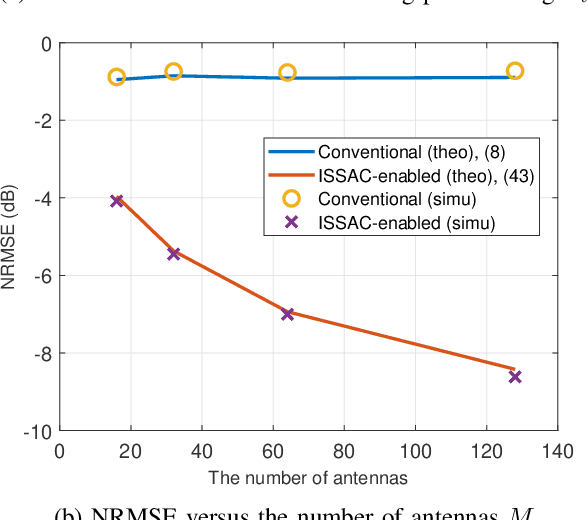
Abstract:Integrated super-resolution sensing and communication (ISSAC) has emerged as a promising technology to achieve extremely high precision sensing for those key parameters, such as the angles of the sensing targets. In this paper, we propose an efficient channel estimation scheme enabled by ISSAC for millimeter wave (mmWave) and TeraHertz (THz) systems with a hybrid analog/digital beamforming architecture, where both the pilot overhead and the cost of radio frequency (RF) chains are significantly reduced. The key idea is to exploit the fact that subspace-based super-resolution algorithms such as multiple signal classification (MUSIC) can estimate channel parameters accurately without requiring dedicate a priori known pilots. In particular, the proposed method consists of two stages. First, the angles of the multi-path channel components are estimated in a pilot-free manner during the transmission of data symbols. Second, the multi-path channel coefficients are estimated with very few pilots. Compared to conventional channel estimation schemes that rely solely on channel training, our approach requires the estimation of much fewer parameters in the second stage. Furthermore, with channel multi-path angles obtained, the beamforming gain can be achieved when pilots are sent to estimate the channel path gains. To comprehensively investigate the performance of the proposed scheme, we consider both the basic line-of-sight (LoS) channels and more general multi-path channels. We compare the performance of the minimum mean square error (MMSE) of channel estimation and the resulting beamforming gains of our proposed scheme with the traditional scheme that rely exclusively on channel training. It is demonstrated that our proposed method significantly outperforms the benchmarking scheme. Simulation results are presented to validate our theoretical findings.
Little Pilot is Needed for Channel Estimation with Integrated Super-Resolution Sensing and Communication
Apr 16, 2024Abstract:Integrated super-resolution sensing and communication (ISSAC) is a promising technology to achieve extremely high sensing performance for critical parameters, such as the angles of the wireless channels. In this paper, we propose an ISSAC-based channel estimation method, which requires little or even no pilot, yet still achieves accurate channel state information (CSI) estimation. The key idea is to exploit the fact that subspace-based super-resolution algorithms such as multiple signal classification (MUSIC) do not require a priori known pilots for accurate parameter estimation. Therefore, in the proposed method, the angles of the multi-path channel components are first estimated in a pilot-free manner while communication data symbols are sent. After that, the multi-path channel coefficients are estimated, where very little pilots are needed. The reasons are two folds. First, compared to the conventional channel estimation methods purely relying on channel training, much fewer parameters need to be estimated once the multi-path angles are accurately estimated. Besides, with angles obtained, the beamforming gain is also enjoyed when pilots are sent to estimate the channel path gains. To rigorously study the performance of the proposed method, we first consider the basic line-of-sight (LoS) channel. By analyzing the minimum mean square error (MMSE) of channel estimation and the resulting beamforming gains, we show that our proposed method significantly outperforms the conventional methods purely based on channel training. We then extend the study to the more general multipath channels. Simulation results are provided to demonstrate our theoretical results.
Can Sparse Arrays Outperform Collocated Arrays for Future Wireless Communications?
Jul 16, 2023Abstract:Multiple-input multiple-output (MIMO) has become a key technology for contemporary wireless communication systems. For typical MIMO systems, antenna arrays are separated by half of the signal wavelength, which are termed collocated arrays. In this paper, we ask the following question: For future wireless communication systems, is it possible to achieve better performance than collocated arrays by using sparse arrays, whose element spacing is larger than half wavelength? The answer to this question is not immediately clear since while sparse arrays may achieve narrower beam for the main lobe, they also generate undesired grating lobes. In this paper, we show that the answer to the above question is affirmative. To this end, we first provide an insightful explanation by investigating the key properties of beam patterns of sparse and collocated arrays, together with the typical distribution of spatial angle difference \Delta, which all critically impact the inter-user interference (IUI). In particular, we show that sparse arrays are less likely to experience severe IUI than collocated arrays, since the probability of \Delta typically reduces with the increasing of |\Delta|. This naturally helps to reject those higher-order grating lobes of sparse arrays, especially when users are densely located. Then we provide a rigorous derivation of the achievable data rate for sparse and collocated arrays, and derive the condition under which sparse arrays strictly outperform collocated counterparts. Finally, numerical results are provided to validate our theoretical studies.
Integrated Super-Resolution Sensing and Communication with 5G NR Waveform: Signal Processing with Uneven CPs and Experiments
May 09, 2023



Abstract:Integrated sensing and communication (ISAC) is a promising technology to simultaneously provide high-performance wireless communication and radar sensing services in future networks. In this paper, we propose the concept of \emph{integrated super-resolution sensing and communication} (ISSAC), which uses super-resolution algorithms in ISAC systems to achieve extreme sensing performance for those critical parameters, such as delay, Doppler, and angle of the sensing targets. Based on practical fifth generation (5G) New Radio (NR) waveforms, the signal processing techniques of ISSAC are investigated and prototyping experiments are performed to verify the achievable performance. To this end, we first study the effect of uneven cyclic prefix (CP) lengths of 5G NR orthogonal frequency division multiplexing (OFDM) waveforms on various sensing algorithms. Specifically, the performance of the standard Periodogram based radar processing method, together with the two classical super-resolution algorithms, namely, MUltiple SIgnal Classification (MUSIC) and Estimating Signal Parameter via Rotational Invariance Techniques (ESPRIT) are analyzed in terms of the delay and Doppler estimation. To resolve the uneven CP issue, a new structure of steering vector for MUSIC and a new selection of submatrices for ESPRIT are proposed. Furthermore, an ISSAC experiment platform is setup to validate the theoretical analysis, and the experimental results show that the performance degradation caused by unequal CP length is insignificant and high-resolution delay and Doppler estimation of the target can be achieved with 5G NR waveforms.
Cramér-Rao Bounds for Near-Field Sensing with Extremely Large-Scale MIMO
Mar 10, 2023Abstract:Mobile communication networks were designed to mainly support ubiquitous wireless communications, yet they are also expected to achieve radio sensing capabilities in the near future. However, most prior studies on radio sensing usually rely on far-field assumption with uniform plane wave (UPW) models. With the ever-increasing antenna size, together with the growing demands to sense nearby targets, the conventional far-field UPW assumption may become invalid. Therefore, this paper studies near-field radio sensing with extremely large-scale (XL) antenna arrays, where the more general uniform spheric wave (USW) sensing model is considered. Closed-form expressions of the Cram\'er-Rao Bounds (CRBs) for both angle and range estimations are derived for near-field XL-MIMO radar mode and XL-phased array radar mode, respectively. Our results reveal that different from the conventional UPW model where the CRB for angle decreases unboundedly as the number of antennas increases, for XL-MIMO radar-based near-field sensing, the CRB decreases with diminishing return and approaches to a certain limit as the number of antennas increases. Besides, different from the far-field model where the CRB for range is infinity since it has no range estimation capability, that for the near-field case is finite. Furthermore, it is revealed that the commonly used spherical wave model based on second-order Taylor approximation is insufficient for near-field CRB analysis. Extensive simulation results are provided to validate our derived CRBs.
SNR Scaling Laws for Radio Sensing with Extremely Large-Scale MIMO
Jun 10, 2021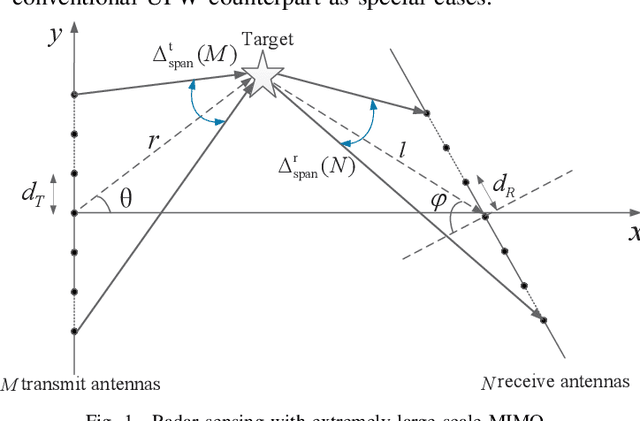
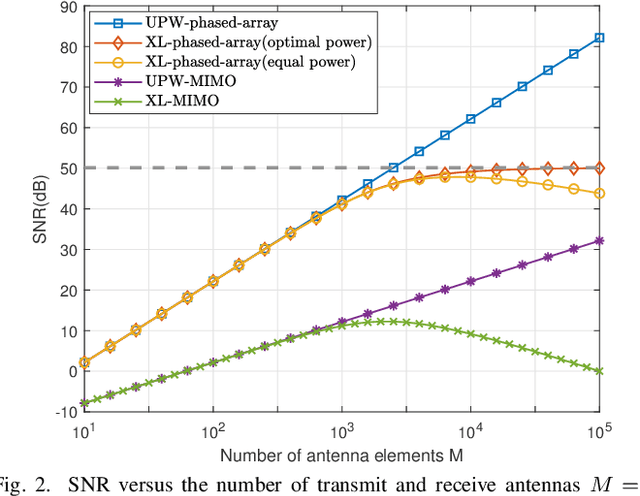
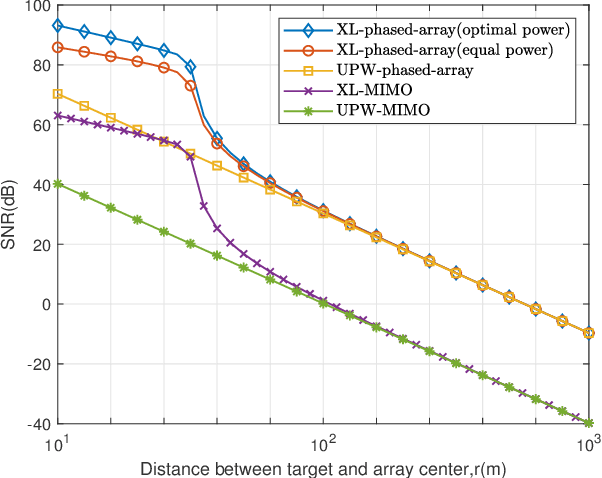
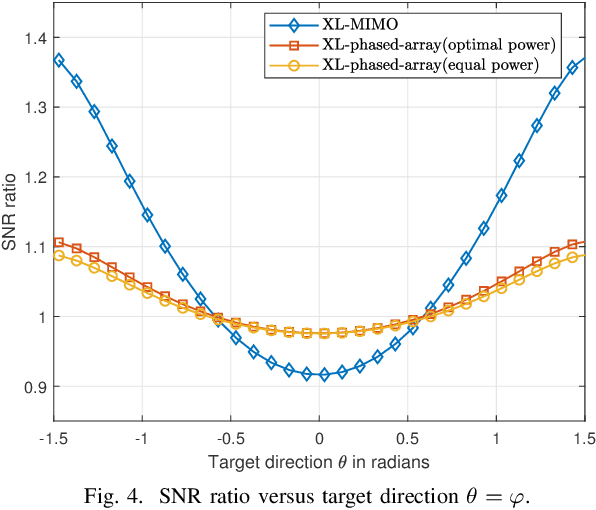
Abstract:Mobile communication networks were designed to mainly support ubiquitous wireless communications, yet they are expected to also achieve radio sensing capabilities in the near future. Most prior studies on radar sensing focus on distant targets, which usually rely on far-field assumption with uniform plane wave (UPW) models. However, with ever-increasing antenna size, together with the growing need to also sense nearby targets, the far-field assumption may become invalid. This paper studies radar sensing with extremely large-scale (XL) antenna arrays, where a generic model that takes into account both spherical wavefront and amplitude variations across array elements is developed. Furthermore, new closed-form expressions of the sensing signal-to-noise ratios (SNRs) are derived for both XL-MIMO radar and XL-phased-array radar modes. Our results reveal that different from the conventional UPW model where the SNR scales linearly and unboundedly with N for MIMO radar and with MN for phased-array radar, with M and N being the transmit and receive antenna numbers, respectively, more practical SNR scaling laws are obtained. For XL-phased-array radar with optimal power allocation, the SNR increases with M and N with diminishing returns, governed by new parameters called the transmit and receive angular spans. On the other hand, for XL-MIMO radar, while the same SNR scaling as XL-phased-array radar is obeyed for N, the SNR first increases and then decreases with M.
 Add to Chrome
Add to Chrome Add to Firefox
Add to Firefox Add to Edge
Add to Edge